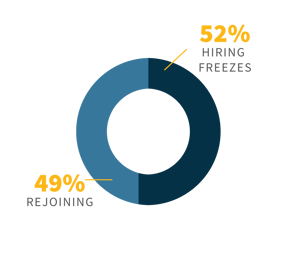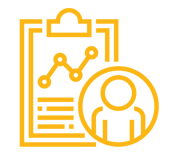By the Sevenstep Team, October/November 2022
Sevenstep's quarterly market Roundup features stories that highlight trends and developments in the workforce landscape. We are pleased to share our views based on our experience helping companies face challenging conditions and new opportunities every day.
Our current Roundup shows that continuing uncertainty about economic direction has begun to influence some aspects of hiring and workforce engagement. The talent supply may rise from its historic lows, and the increase in worker salaries may level off, but the competition for select high-value roles remains significant.
Our stories:
1. Workforce decision-makers react to mixed economic signals.
2. Uncertainty creates an impact on the UK labor market.
3. Employers enhance their focus on skills, not degrees.
4. Companies and workers continue to embrace independent and contingent work.
5. Healthcare organizations adjust to worker shortages and rising costs.
6. A hunger for workforce intelligence drives talent tech innovation.
 WORKFORCE DECISION-MAKERS REACT TO MIXED ECONOMIC SIGNALS
WORKFORCE DECISION-MAKERS REACT TO MIXED ECONOMIC SIGNALSMany traditional assumptions about the workforce and economic trends are not holding true in the current economic climate. A recession does not necessarily mean labor is cheaper. A hiring slowdown does not equate to fewer job vacancies or less competition for workers. And the burden on talent acquisition (TA) is not necessarily shrinking.
Recent statistics reveal an economy that is often contradictory. For example, the US added 263,000 non-farm jobs to its economy from September to August, and unemployment fell slightly from 3.7% to 3.5%. Yet, total job openings in the US fell by approximately 1.1M, or 10.0%, in August from July. As a result, workforce decision-makers are establishing priorities and expressing concerns that reflect the complex nature of the economy today.

Restricted vs Expanded Hiring
52% of surveyed companies implemented hiring freezes, while 49% are encouraging employees who left to rejoin, according to a recent report by Josh Bersin.

Decreasing vs Increasing Compensation
46% are reducing sign-on bonuses, while 64% are increasing compensation, according to the same report.

Prioritizing Hiring
54% of CFOs in a Gartner survey cite hiring and retaining workers as a top challenge.

Cutting Costs
35% cited cutting costs, and 35% cited forecasting as their main challenges in the same study.
Trying to create hiring plans based on big-picture assumptions about the economy and workforce can be frustrating. Instead, build for flexibility, and the TA function can adjust to the changes that will inevitably arrive.

Workforce agility is a priority.
Many internal TA teams focus on hiring needs based on past requirements, compensation, costs and recruiting practices. Today, however, the types and sources of skills in demand may change quickly. When considering talent solutions to support recruiting and contingent workforce management, companies are prioritizing scalability and breadth of capability as fundamental needs for a successful partnership.
Project-RPO offers a responsive option for specific talent goals.
Sometimes, new demands or changing conditions require support that can be applied quickly and efficiently to directly address near-term talent needs. Project-based recruitment process outsourcing (RPO) is one example of a solution uniquely suited to deliver on that demand. Whether staffing a new location, supporting a hiring initiative, or establishing a best practice for acquiring certain skill sets, a project solution can bring the best practices and resources to deliver on specific talent goals.
 UNCERTAINTY CREATES AN IMPACT ON THE UK LABOR MARKET
UNCERTAINTY CREATES AN IMPACT ON THE UK LABOR MARKETNavigating the changing workforce in the UK remains a challenge. The October Labour Market Overview reported an employment rate of 75.5% for June through August, approximately .3% lower than the previous period. The number of vacancies fell by 46,000. This is the third consecutive quarterly drop, but vacancies remained historically high.
Meanwhile, total pay experienced a 6% growth, the most robust rise in history outside of the pandemic. The irony is that real income adjusted for inflation actually fell 2.4%, one of the largest drops in memory. The CIPD's labor market outlook issued in August highlighted trends that remain top of mind through Q4 and into 2023.

Hard-to-fill roles remain an issue
Nearly half of companies (47%) have vacancies defined as hard-to-fill, up slightly from 45% in Q1. As a result, companies continue to focus their TA priorities on tackling hard-to-fill roles.

Steady hiring intentions
The CIPD outlook showed that 41% of respondents planned to increase staff levels while only 7% intended to decrease staff. Even as this figure changes and staff expansion levels of, the competition for available talent will likely remain strong.

Getting flexible in solving
hiring challenges
In response to hiring and retention challenges, companies are taking new measures to meet demand, including upskilling current staff (41%), advertising jobs as flexible (35%), raising wages (29%) and hiring more apprentices (26%).
The challenges of a complex labor market are causing employers to re-examine both their internal talent functions and their external partnerships, including those with RPO and MSP providers. Recently Sevenstep examined rising expectations for talent solutions in the UK and across EMEA. Experience in the region points to several priorities that should shape expectations for the TA function and supporting solutions.

Improve visibility to see ahead.
A highly adaptable data and analytics platform should be a central resource in a solutions provider's arsenal for driving change, setting strategy and steering processes. Innovation in analytics technology makes the difference between drowning in numbers and identifying the best actions for the desired outcome.
Create access to an extended TA capability set.
An RPO or MSP partner must provide resources and capabilities positioned to deploy on demand and deliver on specific needs. Resources must be more than simply larger numbers of people; they must be people trained in the fields, skills and talent types being sought.
Move from HR goals to business goals.
Hiring a role quickly may indicate solid performance, but identifying a way to limit the hiring need by reducing turnover is a path of business impact. By understanding desired outcomes, an effective solutions partner can help reduce the hiring burden and enable the organization to navigate the region's labor market challenges.
 EMPLOYERS ENHANCE THEIR FOCUS ON SKILLS, NOT DEGREES
EMPLOYERS ENHANCE THEIR FOCUS ON SKILLS, NOT DEGREES
More than half of HR professionals (56%) apply skills assessments as part of the hiring process, and 79% value the results of those assessments more than other criteria, such as years of experience. This data comes from research released in August by the Society for Human Resource Management (SHRM).
The term Skilled Through Alternative Routes (STARs) has recently gained visibility as non-profit organizations and employers seek paths to understand and engage overlooked talent with in-demand skills. One organization estimates that 32 million STARs in the US have skills that qualify them for higher-wage work than their current jobs offer. Related data suggests many implications employers should consider, including:
Potential workforce supply: One study found that 50% of the US workforce does not have a college degree, but 69% of new jobs between 2012 and 2019 require a bachelor's degree or higher to apply. Removing degree requirements can dramatically expand access to workers.
Persistent barriers: The same study found that the percentage of STARs holding jobs that provided career gateways to advancement for their skills fell from 54% to 46%, and more than 7 million such jobs were lost to them due to increasing demands for college degrees. There is room to open the door to STARs at the entry-level.
A positive trend: The door to opportunity is quietly opening as employers slowly remove degree requirements from their jobs. Jobs advertised on LinkedIn not requiring degrees rose from 15% in 2020 to 20% in 2022. Reaching out to STARs can yield a competitive advantage in securing talent.
Increasing business focus: One Deloitte survey found that 60% of surveyed business executives valued the concept of "fractionalized work" in which workers flexibly flowed to work and tasks based on their skills. Rethinking an organization's approach to work may help open more opportunities to STARs with vital skills.
Economic forces are likely to accelerate the push toward skills-based hiring as competition for certain workers continues to grow. To put skills at the forefront of talent acquisition, organizations will need to touch on several areas of need.

Rethink roles and skills
Re-defining resource needs by skill instead of traditional role requirements and educational demands is no small task. But the case for doing so is compelling, as skills-based requirements can often open a role to high-quality talent that may otherwise not apply. Organizations are not only reconsidering requirements for established positions, but in more advanced cases, they may consider breaking up and reinventing roles based on how skills are applied.

Adapt the tech stack
The applicant tracking system (ATS) can be a significant barrier to STAR talent, as it may be set up to reject applications quickly based on educational requirements. While the technology itself is not at fault, and adjusting education requirements will fix the issue, the tech stack is important to recognize as the gateway to the application process.

Cast a wider net for talent
When college degrees are removed from job requirements, organizations can focus on sources for talent through paths such as apprenticeships, certifications, and competitive programming "boot camps" and competitions. Internal mobility and employee upskilling are also strong sources of talent for skills-based roles.
 COMPANIES AND WORKERS CONTINUE TO EMBRACE INDEPENDENT AND CONTINGENT WORK
COMPANIES AND WORKERS CONTINUE TO EMBRACE INDEPENDENT AND CONTINGENT WORKAn August McKinsey report cites that 36% of employed workers in the US workforce describe themselves as independent workers, up from 27% in 2016. Meanwhile, September US Bureau of Labor Statistics figures shows that temp jobs, representing a portion of that independent work, comprise 2.09% of total US employment in September, up from 2.07% in August.
Both figures reveal a steady but continuously growing embrace of flexible employment on the part of employers and workers alike. The findings of the McKinsey report also show that the non-employee workforce is likely to remain strong even as it balances optimism and challenges:

High value talent
In the McKinsey study, more than a third of surveyed employed respondents who earn more than $150,000 per year describe themselves as independent workers.

Worker Optimism
Roughly 45% of independents with bachelor's degrees expect economic growth compared to only 35% of the broader employee workforce — a positive outlook at least on par with permanent employees.

Challenges for Workers
Only 32% of flexible workers receive health insurance from their employer. They are 1.5 times more likely to feel the need to pursue training to advance their career, and 62% would prefer to work as permanent employees.
While over two decades have passed since enterprise contingent workforce strategies supported by Managed Services Providers (MSPs) have become mainstream, spending on non-employee talent often remains siloed by department or location. With that in mind, more organizations are stepping up their approach to better engage flexible workers and the agencies that supply them.

Create an enterprise approach to the non-employee workforce. One priority of the MSP is to expand visibility into the universe of contractors and contingent workers and their agencies across the enterprise. This view creates opportunities for significant improvements in cost, speed, and quality of talent.
Keep all options open when considering hires. The best resource for that permanent role may prove to be a contractor, so do not let preconceived rules get in the way. In practice, an MSP or a total talent partner (covering both permanent employees and contingent workers) can provide the technology and processes for breaking the boundaries that stand in the way of talent engagement.
Stay active in measuring impact and refining processes. Contingent workforce suppliers, freelancers and independent contractors all have unique entry points into an organization's work process. Tracking how they are engaged, how they perform, and how they are budgeted requires a committed management effort. A specialized MSP is well-suited to deliver on this demand.
 HEALTHCARE ORGANIZATIONS ADJUST TO WORKER SHORTAGES AND RISING COSTS
HEALTHCARE ORGANIZATIONS ADJUST TO WORKER SHORTAGES AND RISING COSTSHealthcare companies are feeling the pressure of higher demands for workers across clinical, professional and technical roles. The progress of the pandemic contributes to the challenges, as organizations fully maintain non-COVID-related services while also accommodating continuing demand for testing, vaccinations and patient care.
Despite the challenges, some organizations are successfully meeting talent demand. This success is due largely to innovations in practices and technology brought on by the pressures of the pandemic. Moving forward, companies must address persistent workforce challenges that continue to grow. Consider the demands:
A successful talent strategy starts with workforce intelligence. In an October 2022 healthcare event, Noelle Paras, Vice President of Client Services for Sevenstep joined Jeff Lackey, founder of JKL Advisors and former head of talent acquisition at a major US healthcare leader. Together, they explored the role of predictive analytics and talent intelligence in a successful pandemic response. The lessons learned during the 2020-21 period provide a blueprint for the future. Areas of priority include:

Create visibility into the talent supply.
During the pandemic, the talent function at the healthcare organization could pinpoint all worker types aligned to specific roles and qualifications, including permanent, contract, and geography. This visibility continues to play a role in the company's right-talent, right-time, right-cost strategy.
Understand the available TA resources.
A clear view of resources enables the TA team to flex and scale quickly through capacity planning, leveraging what is needed to achieve outcomes on time and at cost. RPO recruiters, internal teams, and contractor staffing all contribute to success.
Measure TA performance in detail.
The organizations prioritized measuring progress and addressing issues as the pandemic unfolded. The effort was made possible because traditional quarterly reporting had been replaced with accurate daily and weekly data around time to fill, efficiency, quality, retention, satisfaction and, importantly, candidate feedback. Today, that same capability enables the company to identify and act quickly on every opportunity to improve performance.
 THE NEED FOR WORKFORCE INTELLIGENCE DRIVES TALENT TECH INNOVATION
THE NEED FOR WORKFORCE INTELLIGENCE DRIVES TALENT TECH INNOVATION The current technology landscape continues to evolve at a rapid pace. According to industry analysts at Aptitude Research, AI-driven solutions are top of mind for nearly every solution provider, and both employers and candidates embrace AI as part of the TA process.
A desire for efficiency in hiring has driven employers to focus on improving sourcing, onboarding and assessments over the past several years, but quality of hire is playing a primary role today. The focus on quality pushes companies to better understand who is the best fit at the best cost and where to focus their talent acquisition effort. Such demand for intelligence fuels new investment in technology and a hunger for data, even as organizations remain unsure of the returns on their technology.
Aptitude's reporting reveals common themes and concerns among employers as they consider their talent technology options, including:

Increasing investment
73% of companies have increased their investment in talent technology since 2021

Unsure returns on technology
Only half of the surveyed companies have measured the ROI of their technology investments

A hunger for meaningful data
67% of TA and HR professionals are not providing hiring managers with the right data to make decisions, and only 32% of senior leaders are confident in their data to support their strategies
Artificial intelligence is part of the innovation landscape that offers the ability to address the demand for meaningful data. Many technology innovations utilize AI and analytics, but few have applied new capabilities in a way that can offer a predictive view of data and performance.

Sevenstep's proprietary Sevayo® Insights platform has tackled that predictive analytics opportunity and serves as an example of the core capabilities organizations should demand from their talent technology. Data aggregation, analysis and predictive analytics are keys to success.
Aggregate and analyze data from all channels.
Smarter decision-making begins by bringing together all data sources into a common view. Sevayo® Insights applies a robust unified data model – along with a modern, flexible data pipeline – to do just that. Sources of input range across the entire talent ecosystem, including recruitment marketing platforms (CRM), applicant tracking systems (ATS), human resource information systems (HRIS), learning management systems, and public employment data.
Apply predictive analytics to create informed, forward-looking decisions.
An upcoming report from Sevenstep and Aptitude Research further explores the process of talent technology innovation, and AI and predictive analytics is a key part of the story. Specifically, predictive analytics is breaking the cycle of reactive decision-making and emerging as the new foundation of strategic talent acquisition and the future of the TA tech stack.
Our next Roundup will examine new opportunities and challenges as companies navigate the 2023 business and talent landscape. Look for more details on the technology front, particularly with workforce intelligence and predictive analytics, as well as updated market data and survey input on TA priorities and pain points. We look forward to sharing insight on these issues and more. If you have questions or input, we would love to hear from you.
Please contact us at: Roundup@Sevensteprpo.com